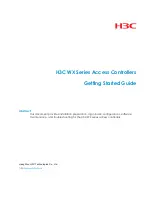
5 INTERRUPT CONTROLLER (ITC)
S1C17M12/M13 TECHNICAL MANUAL
Seiko Epson Corporation
5-3
(Rev. 1.2)
5.3 Initialization
The following shows an example of the initial setting procedure related to interrupts:
1. Execute the di instruction to set the CPU into interrupt disabled state.
2. If the vector table start address is different from the default address, set it to the MSCTTBRL and MSCTTBRH
registers after removing system protection by writing 0x0096 to the MSCPROT.PROT[15:0] bits. Then, write a
value other than 0x0096 to the MSCPROT.PROT[15:0] bits to set system protection.
3. Set the interrupt enable bit of the peripheral circuit to 0 (interrupt disabled).
4. Set the interrupt level for the peripheral circuit using the ITCLV
x
.ILV
x
[2:0] bits in the ITC.
5. Configure the peripheral circuit and start its operation.
6. Clear the interrupt factor flag of the peripheral circuit.
7. Set the interrupt enable bit of the peripheral circuit to 1 (interrupt enabled).
8. Execute the ei instruction to set the CPU into interrupt enabled state.
5.4 Maskable Interrupt Control and Operations
5.4.1 Peripheral Circuit Interrupt Control
The peripheral circuit that generates interrupts includes an interrupt enable bit and an interrupt flag for each inter-
rupt cause.
Interrupt flag:
The flag is set to 1 when the interrupt cause occurs. The clear condition depends on the periph-
eral circuit.
Interrupt enable bit: By setting this bit to 1 (interrupt enabled), an interrupt request will be sent to the ITC when the
interrupt flag is set to 1. When this bit is set to 0 (interrupt disabled), no interrupt request will
be sent to the ITC even if the interrupt flag is set to 1. An interrupt request is also sent to the
ITC if the status is changed to interrupt enabled when the interrupt flag is 1.
For specific information on causes of interrupts, interrupt flags, and interrupt enable bits, refer to the respective pe-
ripheral circuit descriptions.
Note: To prevent occurrence of unnecessary interrupts, the corresponding interrupt flag should be
cleared before setting the interrupt enable bit to 1 (interrupt enabled) and before terminating the
interrupt handler routine.
5.4.2 ITC Interrupt Request Processing
On receiving an interrupt signal from a peripheral circuit, the ITC sends an interrupt request, the interrupt level,
and the vector number to the CPU. Vector numbers are determined by the ITC internal hardware for each interrupt
cause, as shown in Table 5.2.1. The interrupt level is a value to configure the priority, and it can be set to between 0
(low) and 7 (high) using the ITCLV
x
.ILV
x
[2:0] bits provided for each interrupt source. The default ITC settings are
level 0 for all maskable interrupts. Interrupt requests are not accepted by the CPU if the level is 0.
The ITC outputs the interrupt request with the highest priority to the CPU in accordance with the following condi-
tions if interrupt requests are input to the ITC simultaneously from two or more peripheral circuits.
• The interrupt with the highest interrupt level takes precedence.
• If multiple interrupt requests are input with the same interrupt level, the interrupt with the lowest vector number
takes precedence.
The other interrupts occurring at the same time are held until all interrupts with higher priority levels have been ac-
cepted by the CPU.
If an interrupt cause with higher priority occurs while the ITC is outputting an interrupt request signal to the CPU
(before being accepted by the CPU), the ITC alters the vector number and interrupt level signals to the setting in-
formation on the more recent interrupt. The previously occurring interrupt is held. The held interrupt is canceled
and no interrupt is generated if the interrupt flag in the peripheral circuit is cleared via software.
















































